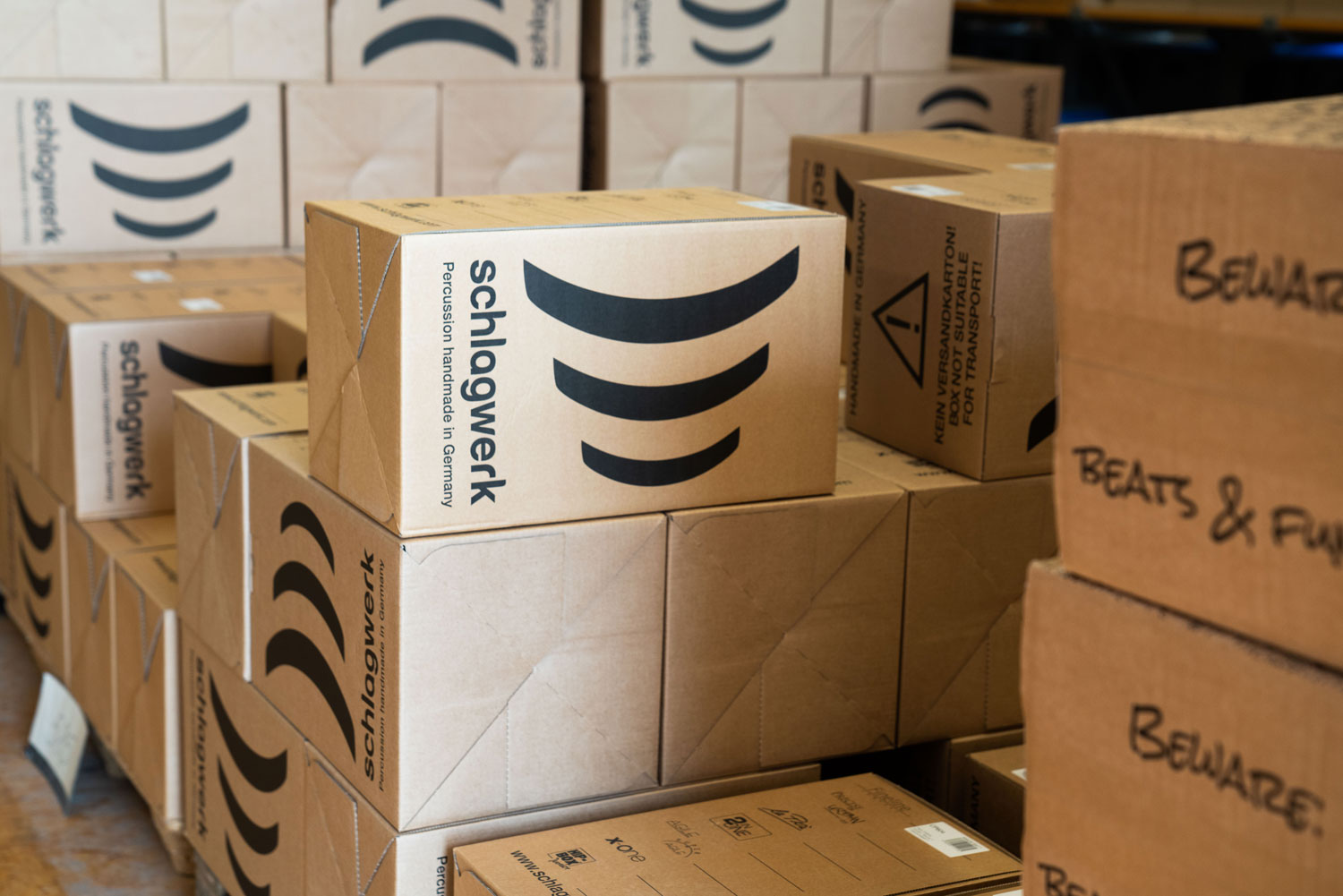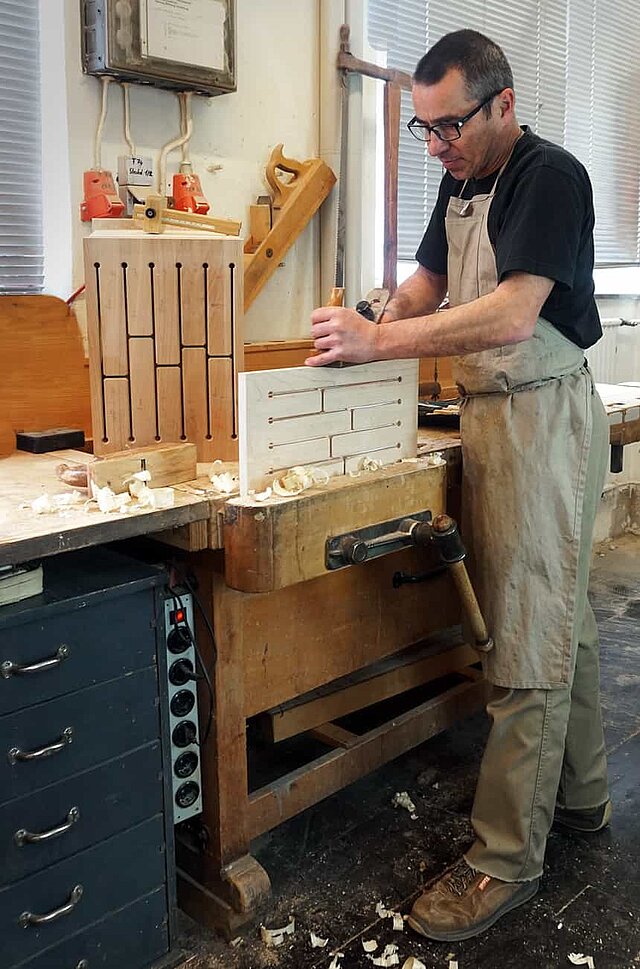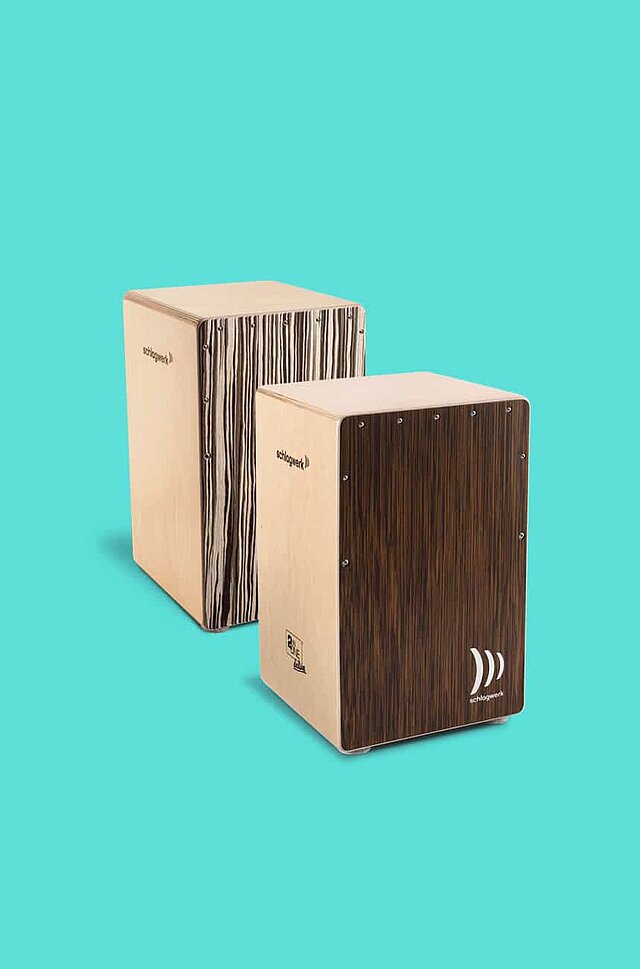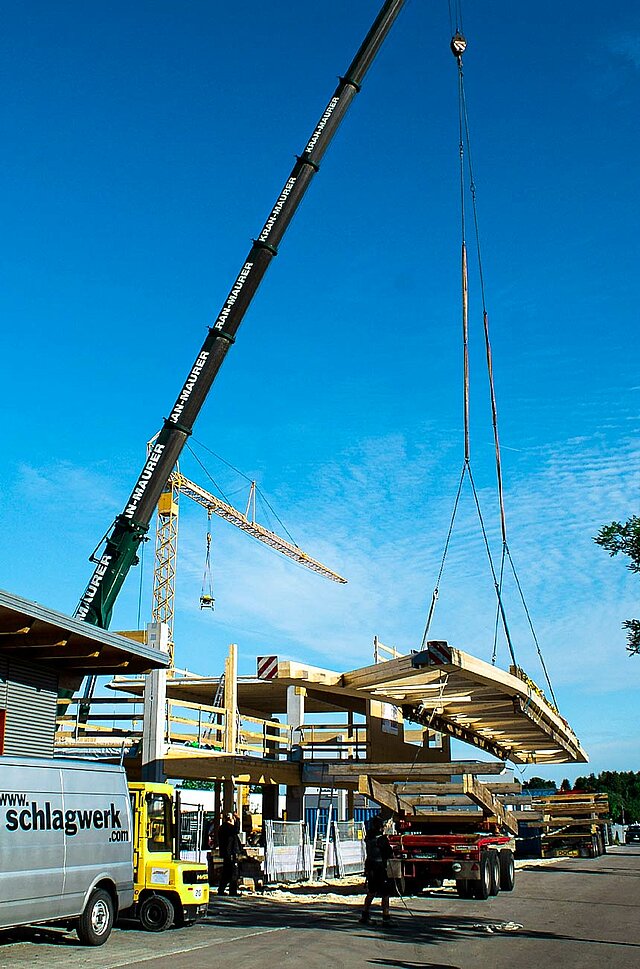-
Tuning
Log Drum tuning
Gerhard Priel, cabinetmaker, founder and owner Schlagwerk.
Before a log drum is finally finished, it has to be tuned. The tuning works by changing the mass on the tongues. We drill the tongues from the inside. Depending on whether the tone needs to be raised or lowered, I drill at the free-floating end, or at the body connection of the tongue. First we tune roughly a bit higher, in order to do the fine-tuning after the complete assembly. Here I am in the process of fine-tuning using a tuner with a piezo pickup. Even a few milligrams of mass reduction by sanding shifts the pitch, so you have to tune carefully. Due to the pentatonic tuning, everyone is able to create melody sequences that are harmonious within themselves.
-

-
Filling
Fill the Shaker
Mrs. D-Argenio, Carpenter.
With our shakers, we also process the cuttings of the Cajon veneers, thus avoiding waste and using our resources down to the last snippet. This is the reason why the colours in the shakers vary. However, the sound components do not change, so that the sound quality always remains the same.
Our Double Shaker is named like that because it is actually made of two sections. A double chamber shaker that allows certain playing techniques that cannot be achieved with a "normal" single chamber shaker. Single shots are as easy to handle as continuous grooves. Here I fill the two chambers with a combination of different shaker beads. The mix here is crucial for the sound, so we use predefined containers to fill the amount and the mix consistently.
-

-
Sticking
Masking tape for our Bodhran
Martin Sauer, Cajon Tester and certified Carpenter.
Although originally an Irish folk instrument, the bodhran, with its surprising versatility, can be used wonderfully in other musical styles. Similar to the Cajon, the Bodhran can be used as a complete drumset substitute.
Here I attach the textile band to cover the tuning screws. In addition, the tape provides further stability. Due to our construction, the head can be tuned without tools and can be replaced by standard 14" drumheads. An ingenious drum - you've got to give it a try.
-

-
Grinding
Grind Udus
Bernhard Weiser, cabinet maker.
Kai Koesling, master ceramist.
Kai: The udus are thrown, drawn, painted and fired in my small workshop.
This real handcraft is incredibly exhausting. It is important here to achieve the same volume at all times, so that even a tonally matched set is available. This is not possible with all of them, so you simply have to try out whether the desired pitch is available, for applications where this is needed at all.
Bernhard: After firing the Udus are very rough and the playing feel would suffer a lot. So we sand the outer surfaces with fine sanding pads and then apply a double layer of varnish afterwards. Furthermore, this way we can catch any hairline cracks before the lacquer is applied. Because only a flawless udu produces this unique sonorous sound.
-

-
Packaging
Pack Cajons
Bettina Binder, Logistics/Warehouse.
Since February of this year, however, we have changed over to 100% cotton bags.
Here I am packing an x-One Cajon in this new bag. In this way we save over 1.6 tons of plastic packaging per year, which would go straight into the garbage after unpacking. The cotton bag, on the other hand, can still be used for all sorts of other things. We have also changed our white Cajon boxes to unbleached brown cartons. Climate protection always starts with oneself - if everyone takes part, it has a big effect in the end.
-
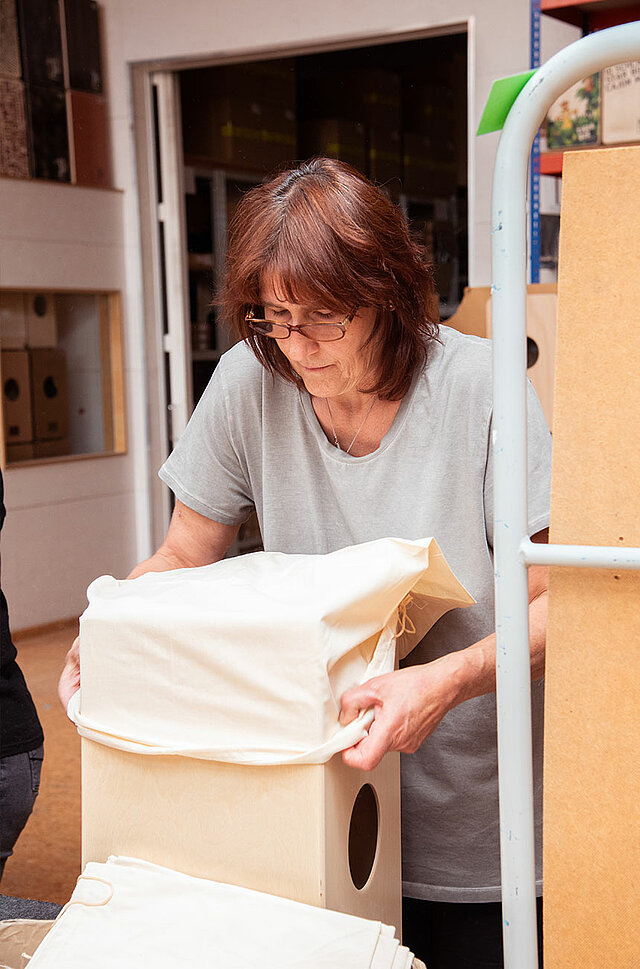
-
Sanding
Sand the Log Drum
Bernd Beuerle, cabinet maker.
Here I sand the rounded edges of our 10-tone drum with Wenge soundboard. The radius milling always leaves small marks and edges, which affect the appearance and also the handling. I now sand these surfaces and edges so that they merge seamlessly and do not interfere with playing by hand. We attach the utmost importance to perfectly crafted instruments. In our opinion, an instrument is not only the sum of its parts. Not only the sound, but also the shape, the appropriate materials and the workmanship contribute to the joy of playing an instrument by hand.
-

-
Shredding
Shred carboard boxes
Ute Walliser, Shipping Department.
In the beginning, cardboard boxes from surrounding businesses were collected in the workshop and used for shipping our own instruments. In the meantime, however, Schlagwerk instruments have become so popular that the surrounding businesses don't throw away enough packaging that it would be enough for our shipping.
Here I shred our padding and filling material from old packaging from supplier parts or damaged cardboard boxes. This way we avoid waste and always have enough padding material.
This is also part of our directive not to use plastic in our packaging until 2021.
We try to conserve resources wherever possible, even if this is sometimes a little inconvenient.
-

-
Printing
Screen printing Sam Jam
Bünyamin Gökalp, painter.
Sam Jam is a percussion accessory that extends the sound possibilities of a guitar with snare sounds. Here I prepare the finished Sam Jams for printing. We screen print most of the parts ourselves. In this process, the desired printing contour is applied to a screen, whereby the areas in the screen that are not to be printed are impermeable to ink, so that printing ink can only be applied to the work piece through the contour. The position and height of the printing screen is decisive for the printing quality. Especially at the Sam Jam the printing area is very small, an exact adjustment of the equipment is very important.
-

-
Glueing
Glue Cajon Comparsa body
Stefan Unger, carpenter.
There are two different play areas available at Comparsa. One side represents a kind of quinto sound in pitch, the other resembles a deeper bass tone like a tumba.
Our Cajon Comparsa is a real gem, both acoustically and optically. It is an instrument for ambitious drummers. Here I prepare the solid wood body for gluing.
For acoustic reasons it is important that the frames are glued at right angles. The aspect ratio is precisely defined! If the frames are not in a 90 ° angle to each other, the Comparsa sounds a bit "distorted".
-
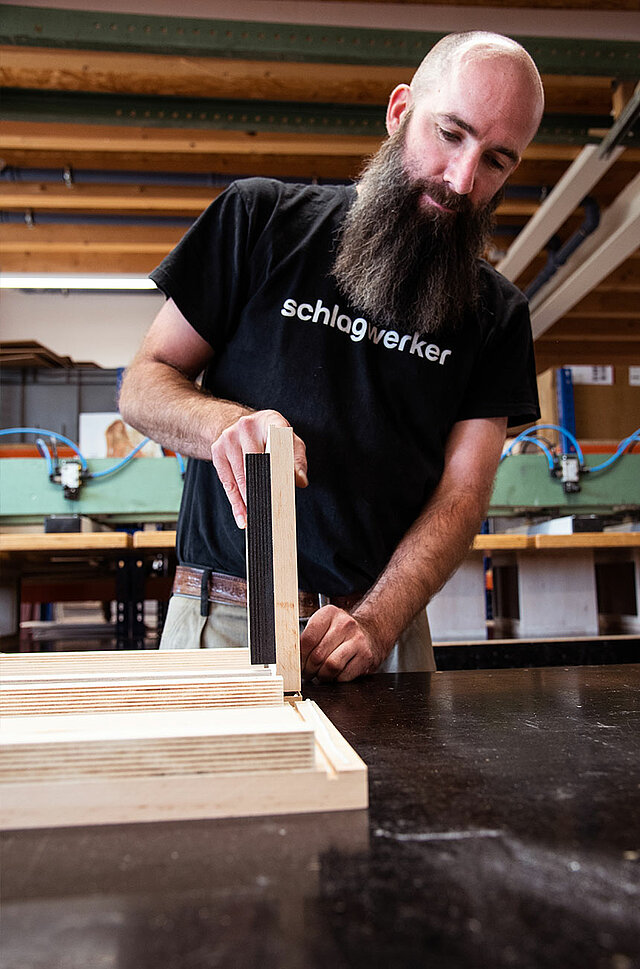
-
Oiling
Oil the Frame Drum
Heike Eisch, Joiner.
Some of the materials we use require special care and attention in production, e.g. our goatskin heads for frame drums.
To keep the natural skins durable, I apply in a two-step process biological hard wax and special grease mixed with beeswax. This has three advantages in use. 1. the heads are more supple and easier to tune 2. they are more resistant to environmental factors such as humidity, spores and hand sweat 3. the beeswax content provides antibacterial protection for the heads.
After all, everyone who owns a Schlagwerk frame drum should enjoy it for a really long time. And should the case arise that a skin is no longer playable, we in Gingen can repair it.
-

-
Control
Cymbals quality control
Markus Schumm, Product Manager.
Our Cajon cymbals are hand hammered by our cymbal smith in Turkey according to our sound specifications. However, as is the case with cymbals of this type, there is a certain spread in the sound characteristics. Even with the greatest care, this can still vary in the post-production phase.
Metal, especially cast B20 bronze, needs as much care as wood in the processing and sometimes has its pitfalls with tensions in the material. Here I compare a new delivery of cymbals with our Master sound sample in-house. If the deviation from the ideal is too strong, I sort out the cymbals. These then go back to the craftsman, are melted down and cast again until they match our sound ideal.
-

-
Selection
Wood selection
Felix Priel, Joiner.
All the handcrafted components must meet the expectations of a master joiner and the sound must meet the expectations of professional musicians. The renowned quality of Schlagwerk instruments is based on these demands, which still apply today. The journey of an instrument begins with the wood selection. Here I check the direction of the grain or flame or flower (as experts call it) during surface sanding. The pieces are stacked and marked accordingly, so that later on the instrument, the grain points upwards. This has no acoustic effect whatsoever, but the overall impression is enhanced on a subconscious level. It simply looks better.
-

-
Drilling
Frame Drum
Sabrina D'Argenio, carpenter. For some of our frame drums we offer a version with a cross support depending on the preferred playing style. These crossbars must withstand the forces that occur during playing. For this reason alone, close tolerances must be maintained in production.
Here I am drilling the joint head into which the cross braces are glued. The four struts then additionally reinforce the drum shell. The head is held in the exact position by a customized template from our workshop. I have to make sure that the drill does not run out of direction at the first contact, otherwise the direction of the struts will not be correct later.
-
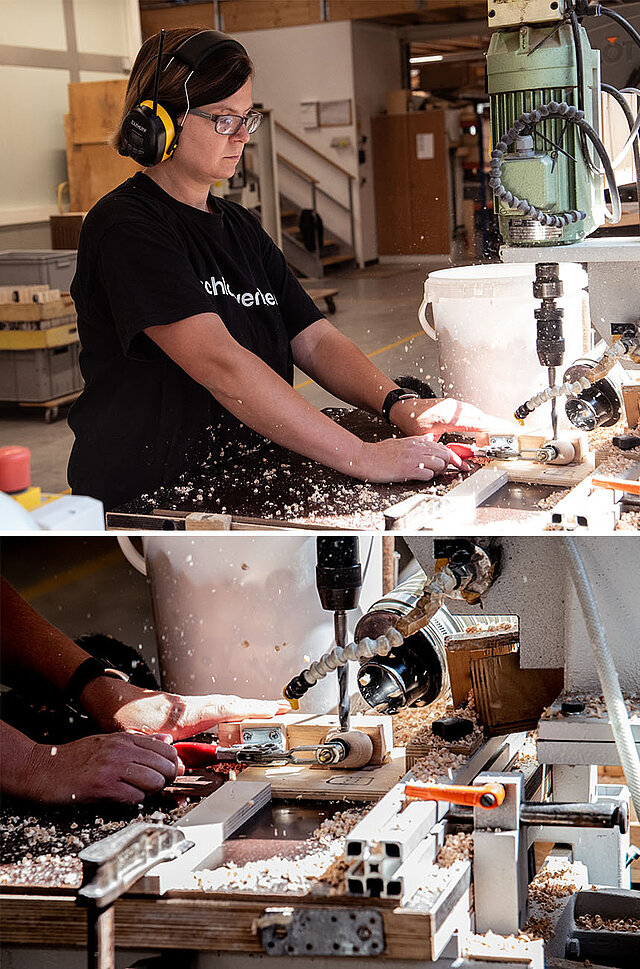
-
Threading
Table Tube
Monika Lauser, Shipping / Final Assembly.
One of our most underestimated instruments is the table tube set. We mount 10 tuned tubes in pentatonic tuning on a wooden frame via a free-floating suspension.
In fact, it is a Schlagwerk specialty that no one else actually builds. In the field of sound and music therapy, this instrument is often used to create room-filling sound landscapes. The trick here is that the tubes can be moved inside the suspension. By moving the tubes the length of the decay can be changed from rather dry and short to never ending.
-
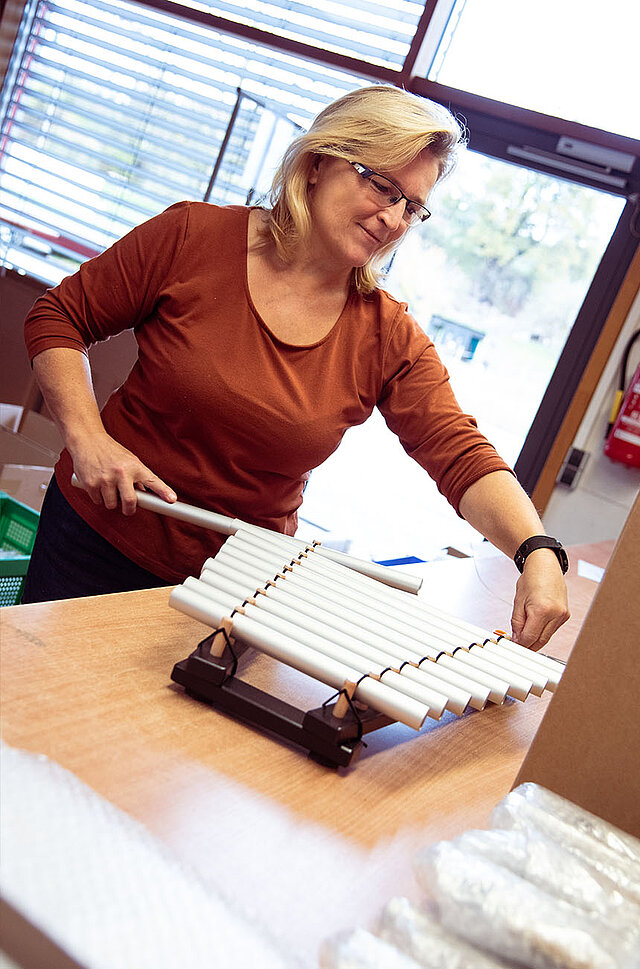
-
Rolling
Roll stamp
Florian Nagel, cabinetmaker.
Our bestselling series is the 2inOne. This is of course due to the sound. On the other hand, it is also due to the meanwhile iconic design. The idea for this came to Gerhard Priel on his way to work when he saw discarded letters punching templates that a company had made for the American Army. The result was the graphics, which for many years was the identification of the Schlagwerk brand.
Even today I still apply this design by hand with a roller. That gives this authentic look, which is always a little different from piece to piece.
-

-
Assembling
Assemble Bodhran
Markus Schumm, Product Manager.
Our new bodhran, has some components in addition to normal bodhrans due to the tunability and the possible head change.
Of course, the assembly is then completely different from our regular frame drums. The tuning screws and the bayonet lock is checked by me here for ease of movement. The problem with manually adjusted tuning screws is that the thread must run as smoothly as possible, so that the noticeable resistance comes only from the head tension. Only in this way can the player adjust the tuning according to his feeling.
-






